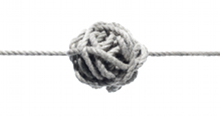Where to start?
Datum: 2012-11-14 11:00

Sometimes when I tell people I am a ”struktör”, I get asked the following question:
”OK. Well, you work with this every day, tell me: what should I do? My office is complete chaos and I have plenty of piles, but I really want to become more structured. How and where do I start?”
This is what I usually reply.
Do this
- First you need to determine where you will keep your to-do-tasks. They should be gathered in one single place. The exception is if you have a CRM-system where you have client-related tasks. In this case you will need two places. You will be able to live with that, but strive to have only one place. It does not matter if it is digital or on paper.
Now you need a to-do-task-place (or ‑list) since numerable things you have to do are most likely hiding in the piles. These tasks will emerge as you go through the piles and will need a place to go where they will not be forgotten. - Now empty your mind of anything you can think of that you have to do and write down all the tasks in detail in the to-do-list. Define all the tasks as small as you possibly can so that each and every task will take less than a day to complete.
You have now taken the first step towards regaining control of your life. - Supply yourself with a box filled with empty hanging file folders or get about ten empty binders, a sizable wastebasket and preferably a scanner.
Now you have somewhere to put any papers you want to keep as reference‑, good-to-have‑, or have-to-keep-material. Some people who clean out their spaces only create new piles since they have not created a better place than their desk to put things they want to keep. - Start going through the pile that most appeals to you. If it is a large pile, start going through the first three inches (the first decimeter).
Take the first piece of paper or material from the top of the pile and ask yourself: “Is there a next step I need to take with this?”. If so, create a new to-do-task and write it on the list. If it constitutes an entire project, add it to your project overview.
If the next step is for someone else to get back to you with a reply or a delivery, make note of this where you keep track of what you are waiting for from others. - Then ask yourself if you really need to keep it. If so, save it in one of the hanging file folders or in a binder. Or, if possible, scan the document, save a digital copy and then throw away the original.
- Keep doing this until you have processed all the piles.
There are many other steps you can take to become more structured in your everyday life, but this is a good start.
Small changes give great results
The people I have helped become more structured in their work often say that they get less stressed when they experience that they know what they need to do and where they have all their materials. Most people who improve on their structure feel less tired after the workday is over and feel more joyful and at ease in their actual work.
What is your way?
When your normally more or less structured office turns into mayhem, what is your way of regaining control and getting back on track? Write a comment to share your thoughts.




